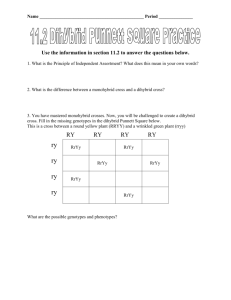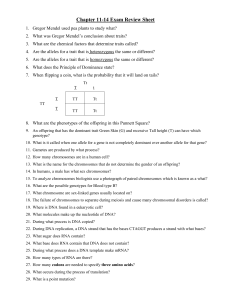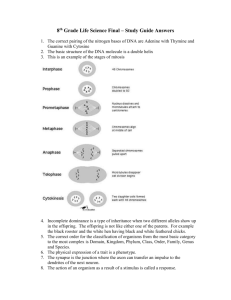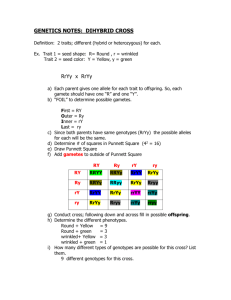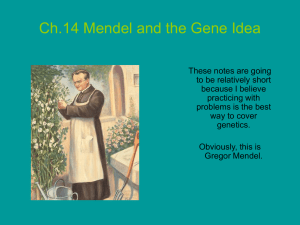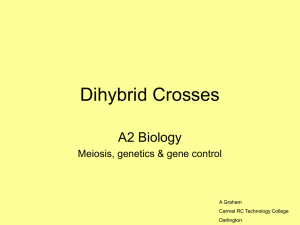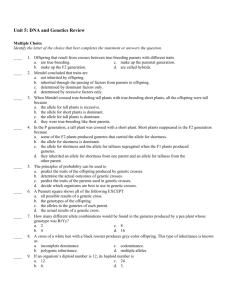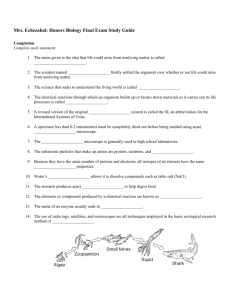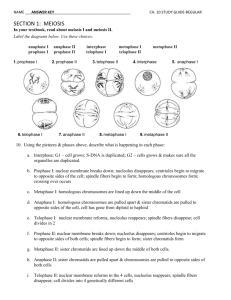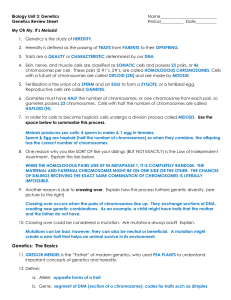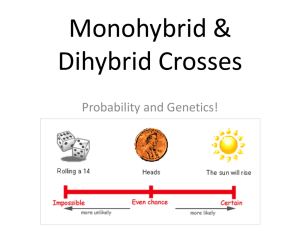Summer Background Pre-Test AP Biology 2012-2013
advertisement
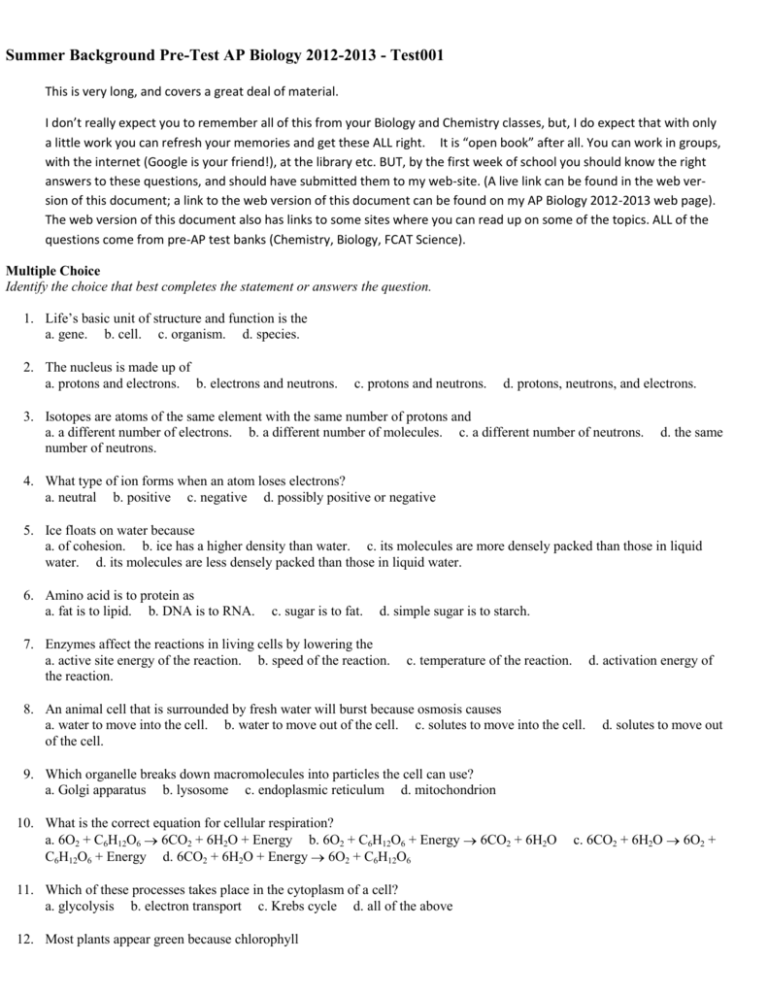
Summer Background Pre-Test AP Biology 2012-2013 - Test001 This is very long, and covers a great deal of material. I don’t really expect you to remember all of this from your Biology and Chemistry classes, but, I do expect that with only a little work you can refresh your memories and get these ALL right. It is “open book” after all. You can work in groups, with the internet (Google is your friend!), at the library etc. BUT, by the first week of school you should know the right answers to these questions, and should have submitted them to my web-site. (A live link can be found in the web version of this document; a link to the web version of this document can be found on my AP Biology 2012-2013 web page). The web version of this document also has links to some sites where you can read up on some of the topics. ALL of the questions come from pre-AP test banks (Chemistry, Biology, FCAT Science). Multiple Choice Identify the choice that best completes the statement or answers the question. 1. Life’s basic unit of structure and function is the a. gene. b. cell. c. organism. d. species. 2. The nucleus is made up of a. protons and electrons. b. electrons and neutrons. c. protons and neutrons. d. protons, neutrons, and electrons. 3. Isotopes are atoms of the same element with the same number of protons and a. a different number of electrons. b. a different number of molecules. c. a different number of neutrons. number of neutrons. d. the same 4. What type of ion forms when an atom loses electrons? a. neutral b. positive c. negative d. possibly positive or negative 5. Ice floats on water because a. of cohesion. b. ice has a higher density than water. c. its molecules are more densely packed than those in liquid water. d. its molecules are less densely packed than those in liquid water. 6. Amino acid is to protein as a. fat is to lipid. b. DNA is to RNA. c. sugar is to fat. d. simple sugar is to starch. 7. Enzymes affect the reactions in living cells by lowering the a. active site energy of the reaction. b. speed of the reaction. the reaction. c. temperature of the reaction. d. activation energy of 8. An animal cell that is surrounded by fresh water will burst because osmosis causes a. water to move into the cell. b. water to move out of the cell. c. solutes to move into the cell. of the cell. d. solutes to move out 9. Which organelle breaks down macromolecules into particles the cell can use? a. Golgi apparatus b. lysosome c. endoplasmic reticulum d. mitochondrion 10. What is the correct equation for cellular respiration? a. 6O2 + C6H12O6 6CO2 + 6H2O + Energy b. 6O2 + C6H12O6 + Energy C6H12O6 + Energy d. 6CO2 + 6H2O + Energy 6O2 + C6H12O6 11. Which of these processes takes place in the cytoplasm of a cell? a. glycolysis b. electron transport c. Krebs cycle d. all of the above 12. Most plants appear green because chlorophyll 6CO2 + 6H2O c. 6CO2 + 6H2O 6O2 + a. does not absorb green light. b. reflects violet light. c. absorbs green light. d. none of the above 13. A student is collecting the gas given off from a plant in bright sunlight at a temperature of 27°C. The gas being collected is probably a. oxygen. b. carbon dioxide. c. ATP. d. vaporized water. 14. When a solid produced by a chemical reaction separates from the solution it is called a. a precipitate. b. a reactant. c. a molecule. d. the mass of the product. 15. What is the small whole number that appears in front of a formula in a chemical equation? a. a subscript b. a superscript c. a ratio d. a coefficient 16. To balance a chemical equation, it may be necessary to adjust the a. coefficients. b. subscripts. c. formulas of the products. d. number of products. 17. During which phase of mitosis do the chromosomes line up along the middle of the dividing cell? a. prophase b. telophase c. metaphase d. anaphase 18. When during the cell cycle is a cell’s DNA replicated? a. G1 phase b. G2 phase c. S phase d. M phase RrYy RY Ry rY ry RY RRYY RRYy RrYY RrYy Ry RRYy RRyy RrYy Rryy RrYy rY RrYY RrYy rrYY rrYy ry RrYy Rryy rrYy rryy Seed Shape R – round r – wrinkled Seed Color Y – yellow y – green Figure 10-2 19. The Punnett square in Figure 10-2 shows that the gene for pea shape and the gene for pea color a. assort independently. b. are linked. c. have the same alleles. d. are always homozygous. 20. Organisms that have two identical alleles for a particular trait are said to be a. hybrid. b. homozygous. c. heterozygous. d. dominant. 21. DNA replication results in two DNA molecules, a. each with two new strands. b. one with two new strands and the other with two original strands. strand and one original strand. d. each with two original strands. 22. During DNA replication, a DNA strand that has the bases CTAGGT produces a strand with the bases a. TCGAAC. b. GATCCA. c. AGCTTG. d. GAUCCA. 23. How many chromosomes are shown in a normal human karyotype? a. 2 b. 23 c. 44 d. 46 c. each with one new 24. Which of the following is caused by a dominant allele? a. Huntington’s disease b. albinism c. cystic fibrosis d. none of the above 25. Colorblindness is more common in males than in females because a. fathers pass the allele for colorblindness to their sons only. b. the allele for colorblindness is located on the Y chromosome. c. the allele for colorblindness is recessive and located on the X chromosome. d. males who are colorblind have two copies of the allele for colorblindness. 26. In the 1800s, Charles Lyell emphasized that a. the human population will outgrow the available food supply. b. all populations evolve through natural selection. c. Earth is very young. d. gradual geological events in the past could explain the physical features of today’s Earth. 27. According to Darwin’s theory of natural selection, certain individuals will leave more offspring on average than do other individuals. Their survival is due to the a. possession of adaptations developed through use. b. possession of inherited adaptations that are well-suited to the environment. c. lack of competition within the species. d. choices made by plant and animal breeders. 28. The economist Thomas Malthus suggested that a. in the human population, people die faster than babies are born. b. populations can grow faster than the rate at which food and resources can be produced. c. evolution occurs when organisms adapt to their environment. d. the majority of a species’ offspring die. 29. Acids react with a. bases to produce salts and water. bases, salts, nor water. b. salts to produce bases and water. 30. Which acid is found in vinegar? a. acetic acid b. nitric acid c. phosphoric acid c. water to produce bases and salts. d. neither d. hydrochloric acid 31. The separation of populations by barriers such as rivers, mountains, or bodies of water is called a. timing isolation. b. geographic isolation. c. behavioral isolation. d. genetic equilibrium. 32. The length of time required for half of the radioactive isotope in a sample to decay is its a. half-life. b. relative date. c. radioactive date. d. geologic time scale. 33. Sometimes, organisms that are not closely related look similar because of a. convergent evolution. b. radiometric dating. c. cladistics. d. punctuated equilibrium. 34. During the Jurassic and Cretaceous periods, the dominant land animals were a. amphibians b. dinosaurs c. grazing mammals d. human ancestors 35. Which of the following is NOT found in bacteria? a. cell wall b. membrane-bound nucleus c. ribosome d. plasma membrane 36. Which of the following do all disease-causing viruses need in order to reproduce? a. reverse transcriptase b. the equipment of the host cell c. amino acids d. a signal from other viruses 37. The Greek letter stands for a. "heat stored in." b. "mass of." c. "rate of." d. "change in." 38. For an exothermic reaction, the products a. are at the same energy level as the reactants. b. have no energy. d. are at a higher energy level than the reactants. c. are at a lower energy level than the reactants. 39. Which affects the Gibbs free energy of a reaction? a. entropy b. enthalpy c. temperature d. All of the above 40. The protozoan Plasmodium is carried by mosquitoes and causes the disease known as a. African sleeping sickness. b. amebic dysentery. c. malaria. d. algal bloom. 41. Activation energy is a. the energy required to form the activated complex. enthalpy of reaction. d. free energy. b. the net energy required to turn reactants into products. 42. Raising the temperature of reactants in a system a. increases the average molecular motion. b. decreases the average molecular motion. molecular motion. d. disturbs the system so that the collision theory no longer applies. c. the c. has no effect on the average 43. How fast something changes with time is a(n) a. area. b. rate. c. order. d. collision. 44. If the surface area of reactants is larger, a. the reaction rate is generally higher. b. the reaction rate is generally lower. rate-determining step is eliminated. 45. Yeasts produce alcoholic beverages by a. distillation. b. respiration. c. fermentation. c. the reaction rate is not affected. d. the d. decomposition. 46. An important role of fungi in an ecosystem is a. photosynthesis. b. breaking down dead organisms. c. making alcohol. 47. Plants use the energy of sunlight to a. produce carbon dioxide. b. take in water from the soil. d. killing bacteria. c. carry out cellular respiration. d. carry out photosynthesis. 48. Which term below is least closely related to the others? a. leaf b. seed c. ovary d. pollen 49. Which group of plants produces seeds that are “naked”? a. bryophytes b. pteridophytes c. gymnosperms d. angiosperms 50. What is the most common oxidation number of combined oxygen? a. –2 b. –1 c. 0 d. +1 51. The loss of one or more electrons from an atom is called a. oxidation. b. reduction. c. electrochemistry. d. half-reaction. 52. The gain of electrons is called a. oxidation. b. reduction. c. electrochemistry. d. half-reaction. 53. In angiosperms, reproduction takes place in a. leaves. b. flowers. c. cones. d. pollen. 54. Plants can respond to changing environmental conditions through chemical messengers called a. sugars. b. enzymes. c. plant pigments. d. plant hormones. 55. The Cambrian explosion was a. a mass extinction at the end of the Cambrian period. b. a burst of animal diversity that occurred about 550 million years ago. c. distinguished by large numbers of dinosaurs. d. the first appearance of early mammals. 56. A person who has trichinosis likely contracted it from a. walking barefoot on soil infested with Trichinella worms. b. eating undercooked meat containing Trichinella cysts. c. mosquitoes. d. coming in contact with Trichinella-infested snails. 57. An example of an arachnid is a a. lobster. b. centipede. c. crayfish. d. spider. 58. In most fishes, the structures that are most important for obtaining oxygen from water are the a. scales. b. gills. c. lungs. d. vertebrae. 59. The eggs of amphibians can dry out easily because they a. are very small. b. do not have shells. c. are usually laid on land. d. are always fertilized externally. 60. One reason for the early success of reptiles was that a. reptiles could reproduce away from water. b. reptiles were strictly aquatic. more humid. d. lakes and swamps became more numerous. c. Earth’s climate became warmer and 61. Which of the following is NOT a characteristic of all birds? a. They have an outer covering of feathers. b. They maintain a constant internal body temperature. legs. d. They can fly. c. They have two 62. Which list represents the levels of organization in the human body from simplest to most complex? a. cell, organ, tissue, organ system b. organ system, organ, tissue, cell c. tissue, cell, organ, organ system tissue, organ, organ system d. cell, 63. In addition to myosin, what other protein is involved in skeletal muscle contraction? a. collagen b. actin c. ATP d. keratin 64. What is the smallest structural and functional unit of the nervous system? a. nerve b. neuron c. brain d. spinal cord 65. Your ability to think about a question and answer it correctly is directly controlled by the a. brainstem. b. cerebellum. c. medulla. d. cerebral cortex. 66. The energy to perform cellular work, as well as the materials from which body cells and tissues are made, comes from a. cellulose. b. oxygen. c. food. d. blood. 67. The essential amino acids the body needs must come from eating a. proteins. b. fats. c. carbohydrates. d. water. 68. A calorie is the amount of energy needed to a. raise the temperature of the body by one degree Celsius. b. raise the temperature of 1 g of fat by one degree Celsius. c. raise the temperature of 1 g of water by one degree Celsius. d. none of the above 69. Which is the correct direction of blood flow? a. right atrium right ventricle pulmonary artery b. right atrium pulmonary artery aorta d. left ventricle left atrium aorta 70. The smallest blood vessels are the a. arteries. b. veins. c. lymphatics. left atrium d. capillaries. 71. The germ theory of disease states that infectious diseases are caused by a. toxins. b. pathogens. c. heredity. d. materials in the environment. 72. All of the following are ways that HIV can be spread EXCEPT pulmonary artery c. left ventricle a. sharing needles for intravenous drug use. b. tending to another person’s bleeding wound when you have a cut on your hand. c. using another person’s hairbrush. d. sexual contact. 73. Negative feedback means that an increase in a substance will trigger a. decreased production of that substance. b. increased production of that substance. substances. d. stopping the production of another substance. 74. A zygote is a a. two-celled embryo. b. solid ball of about 50 cells. c. blastocyst. c. increased production of other d. fertilized egg cell. 75. Which biome is characterized by very low temperatures, high winds, and permafrost? a. desert b. temperate forest c. tundra d. tropical dry forest 76. An organism’s niche is a. an organism’s habitat, its food sources, and other factors specific to its way of life. b. all the physical factors in the organism’s environment. c. the range of temperatures that the organism needs to survive. d. the place an organism lives. 77. The symbiotic relationship between a flower and the insect that feeds on its nectar is most likely an example of a. mutualism because the flower provides the insect with food, and the insect pollinates the flower. b. parasitism because the insect lives off the nectar from the flower. c. commensalism because the insect does not harm the flower and the flower does not benefit from the relationship. d. predation because the insect feeds on the flower. 78. What is the term for each step in the transfer of energy and matter within a food web? a. energy path b. food chain c. trophic level d. food pyramid 79. Organisms that obtain nutrients by breaking down wastes and dead organisms are called a. decomposers. b. omnivores. c. herbivores. d. producers. 80. The total of the variety of living organisms in the biosphere is called a. an ecological pyramid. b. sustainable development. c. biodiversity. 81. Hydrogen peroxide can be decomposed into water d. conservation biology. and oxygen with the use of a catalyst. Which of these will MOST likely increase the rate of the reaction? a. increasing the concentration concentration b. increasing the pressure of the oxygen d. decreasing the temperature of the 82. Which can be broken down chemically into a simpler substance? a. atoms b. compounds c. elements d. isotopes 83. The radioactive decay of iodine is shown in the graph. c. decreasing the catalyst What is the half-life of radioactive iodine? a. 8 days b. 16 days c. 24 days d. 48 days 84. Carbon, silicon, and germanium share many chemical properties. This results from which other similarity these elements share? a. They have the same atomic mass. b. They have the same atomic number. electrons to protons. d. They have the same valence electron configuration. c. They have the same ratio of 85. Respiration is a process during which energy is released from glucose. This energy is used for processes such as growth of the body. Which type of energy is used in this process? a. chemical b. kinetic c. radiant d. thermal 86. The diagrams show cellulose and starch, both of which which are large carbohydrate molecules made by plants. Humans can use starch as an energy source but are unable to use cellulose for energy. Which reason BEST explains the difference in how these molecules are processed in the body? a. Humans can chew starch but cannot chew cellulose. b. Humans can digest starch but cannot digest cellulose. c. Human muscle cells can absorb starch but cannot absorb cellulose. d. Humans dissolve starch in blood plasma but cannot dissolve cellulose. 87. In aerobic cellular respiration, glucose and water is broken down to produce carbon dioxide This reaction is necessary for the production of energy. The law of conservation of mass is correctly demonstrated in which statement about the process of cellular respiration? a. The mass of glucose is equal to the total mass of the water molecules. b. The mass of the glucose is conserved in the energy molecules in the products. c. The total mass of oxygen is conserved in the total mass of carbon dioxide produced. d. The total mass of glucose and oxygen is equal to the total mass of carbon dioxide and water. 88. A euglena is a photosynthetic microorganism that moves by making whip-like motions with its long flagellum. Which of these is a response to an external stimulus? a. expulsion of waste b. production of glucose c. size of the chloroplast d. movement toward light 89. A man has a recessive genetic condition. His wife does not have this condition. However, she is a carrier. Based on this information, which Punnet square correctly predicts the probability that their children will have this genetic condition? a. b. c. d. 90. Sickle cell anemia is a genetic condition that occurs because of a single point mutation in the DNA gene for hemoglobin. How is this mutation expressed in humans? a. The carbohydrate coded by the DNA has a different structure. b. The protein coded by the DNA has a different amino acid sequence. c. The chromosome carrying this gene changes shape during cell reproduction. d. The hormones in the blood are changed by increased differences in genes. 91. The overall roles between DNA and RNA are illustrated. Which process is represented at Point 3? a. mutation b. replication c. transcription d. translation 92. Over several years, a scientist successfully isolates a species of flower for white color. This year, when the new generation of flowers bloom, one yellow flower is found in the population. Which is the BEST reason for the appearance of a new flower color within the species? a. adaptation b. replication c. genetic mutation d. spontaneous generation 93. In a population of brown snakes, a snake is born with a white-spotted pattern. Which factor will have the GREATEST influence on whether this trait will become common in the brown snake population? a. the ability of the snake to survive to reproduce b. the appearance of other new traits in the baby snake c. the d. the presence of the spotted pattern among other young history of the pattern in previous snake populations snakes 94. A population of long-necked giraffes share a habitat with a second population of organisms that eat the leaves of low-growing vegetation. A scientist speculates that if the second population leaves the area, the giraffe population could exhibit shorter necks over time. Which mechanism could result in the giraffe population exhibiting shorter necks? a. The long-necked giraffes would breed with a short-necked species. b. Giraffes with a genetic mutation for short necks would survive and reproduce. c. The presence of food on shorter plants would lead to a relaxation of giraffe necks. d. Giraffes would learn to bend their necks while feeding, causing a shortening of neck muscles. 95. Leaves fall from deciduous trees onto the forest floor. These leaves decay slowly and become part of the topsoil. Which change is MOST likely to have a positive impact on the nutrients available in the topsoil? a. a decrease in temperature b. a decrease in biodiversity increase in the number of decomposers c. an increase in the number of predators d. an 96. Lions tend to prey on primary consumers like zebras and gazelles. If there were a sudden decline in a population of lions, which ecological imbalance would MOST likely occur in the habitat? a. overgrazing b. eutrophication c. invasion by non-native species 97. Living plants perform photosynthesis, according to this reaction. What stays constant throughout the photosynthetic process? d. overproduction of greenhouse gases a. the types of atoms present b. the types of molecules present d. the amount of energy stored in the molecules c. the arrangement of the chemical bonds 98. Florida scrub jays are songbirds found mostly in dry, upland habitats. During a study that lasted several years, a researcher found that the number of breeding pairs of Florida scrub jays in the study area remained relatively constant. For approximately every 25 acres of land, there was only one breeding pair. Which is a limiting factor that MOST likely prevents an increase in scrub jays in this habitat? a. the amount of food available in the area b. the suitability of male scrub jays as mates c. the number of daylight hours during breeding season d. the tendency of young scrub jays to remain in the same area 99. Certain seed-eating birds are able to crack seeds according to the size of their beaks. Long beaks can crack larger seeds, whereas shorter beaks can crack smaller seeds. A graph of a bird population with different-sized beaks is shown below. After a drought occurred several years ago, smaller seeds became scarce, but drought-resistant trees continued producing larger seeds. What graph would BEST predict the change in beak length of the bird population? a. b. c. d. 100. Both graphs represent different population growth models. In Graph 1, there are no external factors acting on a population. What is the MOST likely factor causing the change in Graph 2? a. the maximum rate of adaptation b. the limitation of genetic diversity d. the limitation of available resources c. the maximum rate of reproduction
